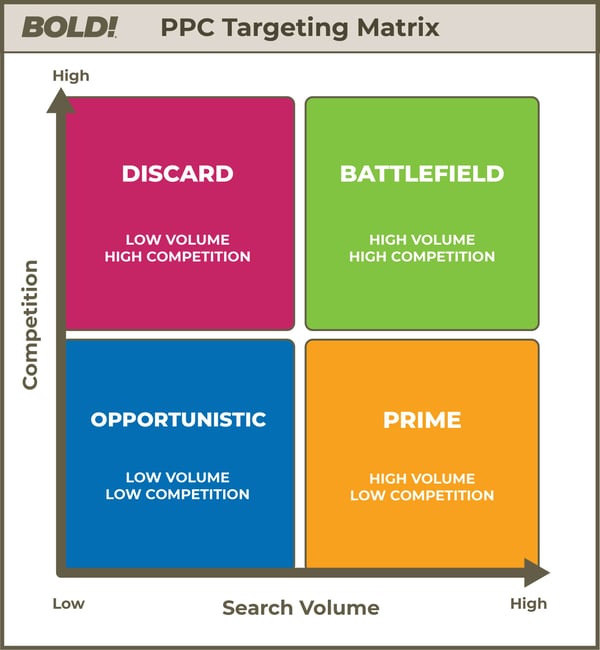Creating an Amazon Sponsored Product Campaign is a powerful way to drive brand awareness, get your product in front of a wider audience, and ultimately boost sales. While there are newer and, in some ways more interesting, tools now available on Amazon, Sponsored Products are still the foundation of most Amazon marketing plans. Here are 6 tips for getting the most out of this tool.
1. Prioritize the Right Items
Before you get started, take some time to evaluate which products in your eCommerce portfolio will respond best to a sponsored product campaign. To determine the best-fit items, consider:
Price
At a basic level, paying $1 per click for a $35 product is going to pay off much more than paying $1 per click on a $5 item. Before you begin to conduct SEO research and compare PPC rates, consider which items are worthy of your time and attention from a purely economic standpoint or make sure you adjust your bids appropriately to maximize profitability.
Right to Win
Beyond price, it’s important that the item you choose for your campaign has a right to win from a competitive standpoint. Although it may be tempting to invest your entire eCommerce advertising budget into the hottest category, if your competitor has a better offering in that category, the extra visibility might not result in more customer conversions. Instead, invest in categories where you can “close the deal.”
It’s possible to do very well in categories with untapped market potential, or white space. To identify white space, examine the relationship between competition and demand for each category. For example, your butter flavor popcorn may be more popular than your chocolate peanut butter popcorn, but the butter flavor may also have more established competition (and thus limited available market share). On the other hand, your chocolate peanut butter flavor may have less demand, but also have significantly less established competition. In many cases, earning a greater market share of a smaller market will earn you more ROI.
2. Hone Your SEO Focus
To understand demand and competition, you need to look at hard data. As you look at different keywords, the two most important metrics to consider are search volume and competition. To simplify the qualification process, we like to break up keyword research into a matrix with four distinct quadrants.

The most ideal keywords (i.e., the best items/categories to target in your PPC campaigns) will have high search volume and low competition, falling into the “prime” lower right-hand quadrant of the graph. That said, locating these keywords can be difficult without the right data and tools.
The second-best place to focus your attention is on the “opportunistic” low volume, low competition quadrant. Although one low volume keyword isn’t bound to drive significant traffic by itself, stacking a collection of low volume, low competition keywords can be an effective strategy to capitalize on words that your competitors have missed. Words in this quadrant are often misspellings (ex: “protien bars”).
In addition to conducting keyword-based targeting, Amazon now allows sellers to target ads by product category, star rating, and brand. In other words, you can identify a competitor, an item, or a set of items, and target ads at shoppers who are looking for or have purchased those items. For instance, if you’re selling winter gloves, you may decide to target people who have previously purchased a brand of hand warmers or who are looking at a specific competitive listing for gloves. This type of targeting requires you to think beyond a specific category and take a more solution-based approach to selling.
3. Consider Timing
Sponsored Product campaigns are most successful when they’re used as part of a larger marketing, promotion, and sales strategy. The best time to launch your campaign is often right when you release a new product, not months down the road when you no longer need as much help with visibility. Launching a new product without the help of Sponsored Products or other advertising tools can lead to a negative sales history, which will have a long-term effect on your search rankings. Poor initial sales numbers cause Amazon’s A9 search algorithm to see your item as unsuccessful and subsequently rank your item lower in search results. This can create a difficult situation for your brand.
Once you’ve successfully launched your product and generated consistent daily sales, you can choose to run evergreen campaigns and/or occasion-based campaigns. Evergreen campaigns run throughout the year and are intended to help target the day-to-day demands of your ideal shopper. In contrast, occasion campaigns are typically centered around giftable items that fit with specific holidays or other events. The items that you highlight and the targeting strategy you use for occasion-based campaigns should have a clear fit with the period. For instance, you may choose to highlight your electric razor item on Father’s Day and bid on the phrase, “great gifts for dad.” Oftentimes, using one of these phrases is not enough — use your favorite SEO research software to find all the popular options.
4. Use Automatic Ad Groups to Support Your Manual Efforts
As you build your Sponsored Products strategy, you’ll want to use a mix of manual and automatic campaigns to be most effective. While manual campaigns require you to identify specify keywords to target, automatic campaigns use algorithms to identify new keywords over the lifespan of your campaign. Automatic campaign are helpful for identifying new keywords that fit your brand that you might have missed in your initial assessment.
Although there are no hard and fast rules, spending around 70 percent of your PPC budget on manual campaigns (informed by your right to win assessment and SEO research) and 30 percent on automatic campaigns is a good starting point.
To improve your PPC strategy (and optimize your spending), continue to move, or “harvest” words identified by your automatic campaign into your manual campaign over time. Once you transfer a word into your manual campaign, make sure to add it as a negative keyword in your automatic campaign so that it doesn’t keep reappearing. As you create new groups, use consistent naming conventions so that they’re easy to identify and remember.
5. Optimize as You Go
To be truly successful, sponsored product campaigns require daily and weekly attention. On a daily basis, use automation software to review your ACOS (Advertising Cost of Sales) for each keyword and adjust bids according to your identified range (often 10-30%). On a weekly basis, human intervention is important. Dig into individual campaigns, especially those performing “out of tolerance” to determine what’s working and what’s not. Re-allocate spend across campaigns to favor what’s working in the moment. That Father’s Day campaign we mentioned before? If it’s blowing the doors off, put more money behind it now!
6. Make Sure You’re Learning Over Time
Rather than treating each Sponsored Product campaign as a one-off, use the data you accumulate to inform future Sponsored Product campaigns. By consistently monitoring your progress and consolidating your insight over time, you’ll give yourself the insight you need to continue to improve. Consider conducting a quarterly PPC review to summarize major results and document key insights learned each quarter. You’ll thank yourself next year.
Doing all of this right can be a game changer for your business. Doing it wrong, however, can be incredibly expensive and frustrating. If you don’t have the time, manpower, or expertise to devote to managing your Amazon campaigns effectively, it may be time to think about the benefits of partnering with an eCommerce consultancy. For more insider tips and tricks on how to create and manage a successful Amazon eCommerce marketing strategy, download our latest free e-book below.






